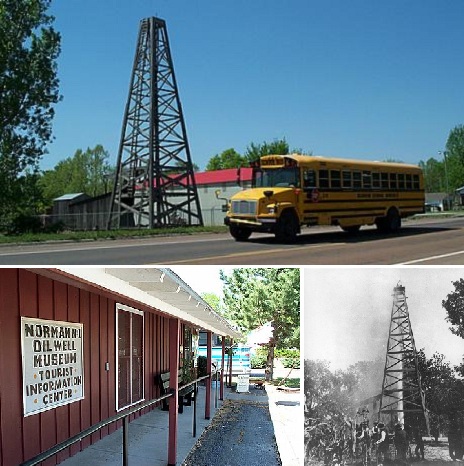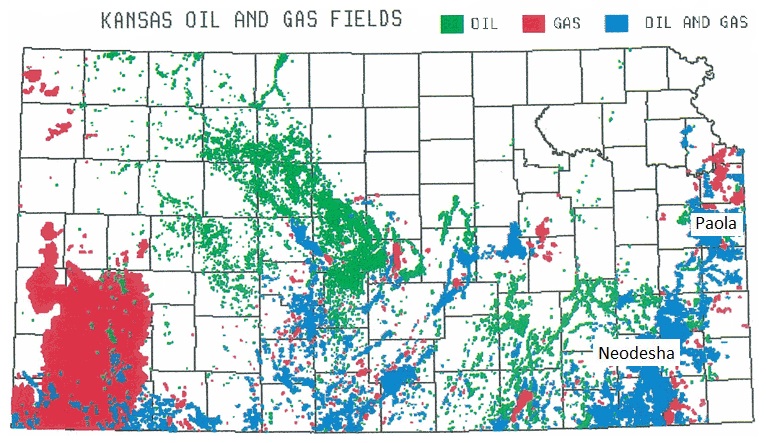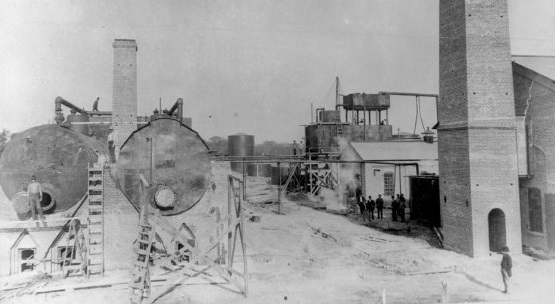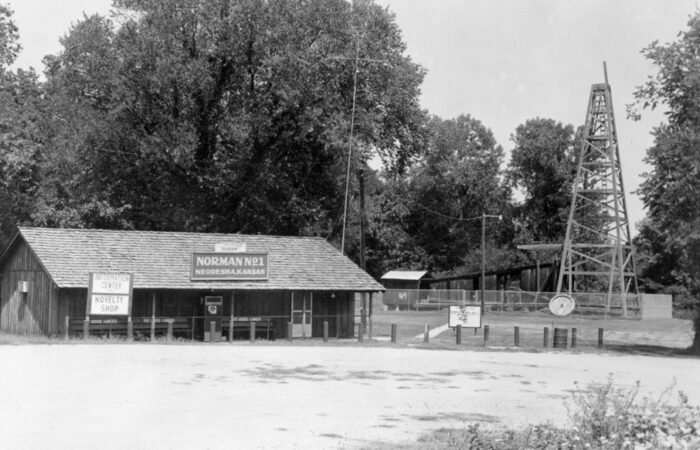Natural gas discoveries and an 1892 oil well at Neodesha revealed giant Mid-Continent fields.
Small amounts of oil found in 1892 at Neodesha in eastern Kansas would be called the first commercial oil discovery west of the Mississippi River — although the driller had been searching for natural gas. The search for the Sunflower State’s petroleum resources began decades earlier.
In 1860, George Brown, a newspaperman in Kansas Territory, recalled stories about an oil spring in Lykins County. Brown, who had arrived a few years earlier from the Pennsylvania oil regions, gathered a few partners and drilled three shallow wells one mile east of Paola.

The Norman No. 1 Well Museum in Neodesha, Kansas, preserves the state’s extensive oil heritage. Color photos by Tim Wells.
One year earlier, America’s first commercial oil well had been drilled near Titusville, Pennsylvania, creating a new kind of entrepreneur that began searching for oil seeps in other states. Refineries wanted the “rock oil” to make a popular lamp fuel, kerosene.
After two failed attempts — dry holes — the third well had reached about 100 feet deep on Baptist Indian Mission grounds owned by David Lykins when it produced a few barrels of oil. But the Civil War ended his quest for oil riches.
Other exploration companies returned to Lykins County (renamed Miami County in 1861) after the war, but it would be almost two decades before Kansas became a producing state — thanks to a natural gas discovery.
Natural Gas Well at Paola
In 1882, the Kansas Oil and Mining Company drilled for oil on the Westfall farm, seven miles east of Paola. Instead of oil, the well uncovered what turned out to be a giant natural gas field. By the mid-1880s, Paola was the first Kansas town to use natural gas commercially for illumination, reportedly the first to do so west of the Mississippi River.
As more drilling companies completed gas wells, Paola’s city council instructed its “light committee” to purchase 50 lamps to be erected on the main thoroughfares. Four flambeaux arches were erected in the town square to attract industries from Kansas City (also see Indiana Natural Gas Boom).

A 1985 map of Kansas petroleum fields includes the giant Hugoton natural gas field discovered in 1919 in the southwestern part of the state. Map courtesy Kansas Geological Survey.
“Paola has the cheapest fuel in Kansas,” civic leaders declared in 1887 as new, gas-fueled flour mills and glass factories opened. But with limited technologies and little understanding of conservation, Paola’s wells started to run dry. Fortunately, another petroleum boom soon began in Kansas.
First Kansas Oil Well
About 110 miles southwest of Paola, on November 28, 1892, after 22 days of difficult drilling, the Norman No. 1 well found oil at Neodesha in Wilson County. The first commercial oil well in Kansas was completed in a garden plot belonging to T.J. Norman, a local blacksmith.
William Mills made the discovery along the banks of the Verdigris River. Since he had been drilling for natural gas (near natural oil seeps) he temporarily capped the well, which was about 830 feet deep.

Oil flowing from Kansas wells marked the beginning of production from Mid-Continent fields.
Mills decided to take a sample of his oil to Pittsburgh, Pennsylvania, “to see if he could raise interest in that more oil-savvy area,” noted Larry Skelton of the Kansas Geological Survey in a 2006 article for the Petroleum History Institute. Mills met with two experienced independent oil operators, John Galey and James Guffey.
Galey and Guffey convinced Mills to form a partnership, and together they returned to Neodesha to “shoot” the well. To improve production, they detonated 30 quarts of nitroglycerine that had been hauled (carefully) by wagon from Webb City, Missouri.
Although it initially produced less than 12 barrels of oil a day, the Norman No. 1 well was the first to reveal America’s Mid-Continent petroleum region, today including oil and gas fields in Nebraska, Oklahoma, Arkansas, Louisiana, and Texas.

A Standard Oil refinery in Neodesha processed 500 barrels of oil a day in the late 1890s. Photo courtesy Kansas Historical Society.
“Norman No. 1, by opening up the Mid-Continent field, made possible the competition that eventually broke Standard Oil’s stranglehold on the American petroleum industry,” noted the Kansas Historical Society in 2010.
Thanks to the Pennsylvanians, the Neodesha discovery attracted the attention of men willing to risk large amounts of money on Kansas as a source of oil, according to the local oil museum. The petroleum industry pioneers also invested in infrastructure like pipelines. Kansas refineries began turning oil into inexpensive kerosene for lamps – and soon, gasoline for automobiles.
In 1901, Guffey and Galey used their success in Kansas to provide financial backing for the “Lucas Gusher” discovery well at Spindletop, Texas. Just one year earlier, the first U.S. auto show at Madison Square Garden in New York City drew thousands to see steam, electric, and gasoline powered automobiles.
By 1904, Kansas was producing four million barrels of oil per year. With new oil and natural gas field discoveries making headlines, in 1906 a highly pressurized gas well at Caney, ignited. Given technologies of the day, it and took five weeks to bring under control (learn more in Kansas Gas Well Fire).
The Stapleton No. 1 well, drilled in 1915 east of Wichita, launched yet another Kansas oil boom. By 1925, the state ranked fifth in oil production. Natural gas wells also were completed between Neodesha and Bartlesville, Oklahoma, where an 1897 gusher had launched the Indian Territory’s oil industry.
In 1919, a wildcat well in southwestern Kansas discovered the massive Hugoton natural gas field that extended into Oklahoma and the Texas Panhandle. That Seward County gas well would be capped for three years, since the company had been looking for oil and there were no pipelines for the gas.

A 1960s image of the Neodesha Oil Museum with its replica Norman No. 1 derrick. Photo courtesy the museum, which moved to Main Street in 1989.
Abandoned in 1919, the Norman No. 1 wellsite along the Verdigris River was designated a U.S. National Landmark in 1977. The Norman No. 1 Museum (and R.V. park) includes a 65-foot replica derrick of the first Kansas oil well.
The Kansas Historical Society’s photography collection in Kansas Memory includes photos of the Norman No. 1 well capturing the excitement it brought to Neodesha.
The Kansas Oil Museum in El Dorado, Butler County, educates visitors about the Mid-Continent oilfield — first in the country revealed using the new science of petroleum geology.
_______________________
Recommended Reading: The fire in the rock: A history of the oil and gas industry in Kansas (1976); History of Paola, Kansas (1956); Caney, Kansas: The Big Gas City (1985). Your Amazon purchase benefits the American Oil & Gas Historical Society. As an Amazon Associate, AOGHS earns a commission from qualifying purchases.
_______________________
The American Oil & Gas Historical Society (AOGHS) preserves U.S. petroleum history. Become an AOGHS annual supporting member and help maintain this energy education website and expand historical research. For more information, contact bawells@aoghs.org. Copyright © 2024 Bruce A. Wells. All rights reserved.
Citation Information – Article Title: “First Kansas Oil Well.” Authors: B.A. Wells and K.L. Wells. Website Name: American Oil & Gas Historical Society. https://aoghs.org/petroleum-pioneers/kansas-mid-continent-oil-fields. Last Updated: November 22, 2024. Original Published Date: June 19, 2014.


